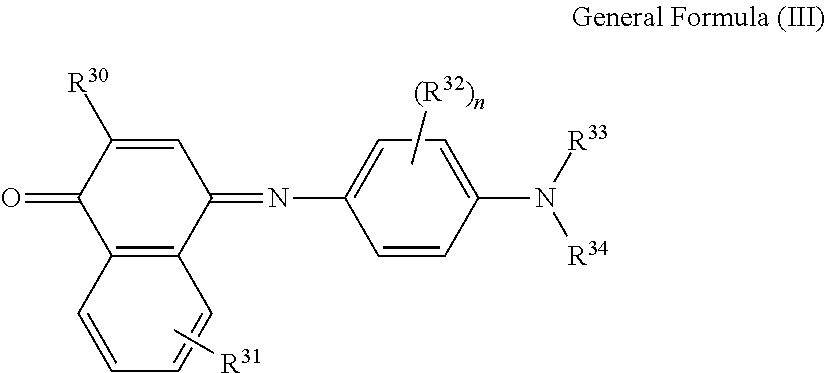Polymerizable composition for solder resist, and solder resist pattern formation method
- Summary
- Abstract
- Description
- Claims
- Application Information
AI Technical Summary
Benefits of technology
Problems solved by technology
Method used
Image
Examples
examples
[0401]Hereinafter, Examples of the present invention will be described, although the present invention is not restricted to the Examples by any means. Unless otherwise specified, “part(s)” and “%” are based on mass.
[0402]Components of the following formulation 1 were kneaded by a kneader for 30 minutes and then, subjected to high viscosity dispersion treatment by twin rolls to obtain a dispersion product. At that time, the dispersion product had a viscosity of 40000 mPa·s.
(Formulation 1)
[0403]Titanium black 13M-C having an average primary particle diameter of 75 nm (manufactured by Mitsubishi Materials Corporation) (Pigment Black 35): 40 parts
[0404]Propylene glycol monomethyl ether acetate (solvent: hereinafter may be referred to as PGMEA) solution of Exemplary Compound 13 (Mw: 20000) (solid content: 40%): 12 parts
[0405]To the obtained dispersion product, a mixture of the following formulation 2 was added and the mixture solution was stirred in a homogenizer under the conditions of ...
example 16
Synthesis of Binder Polymer B (Polyamic Acid 1 as Polyimide Resin Precursor) Corresponding to Specific Binder Resin B
[0492]In a 1000-ml four-necked flask equipped with a thermometer, a stirrer, a raw material feeding nozzle, and a nitrogen gas introducing tube, DPM (4,4′-diaminodiphenylmethane: 24.454 g) and dry NMP (436.86 ml) were placed and dissolved while stirring under a dry nitrogen stream. PMDA (pyromellitic acid dianhydride: 13.451 g) and CBDA (cyclobutane tetracarboxylic acid dianhydride: 12.095 g) were added to react for 24 hours, while maintaining a temperature of the reaction system in a range of 70° C., whereby an NMP solution of polyamic acid 1 was obtained. The obtained polyamic acid had a molecular weight by GPC of 75,000.
[0493]—Polymerizable Composition Solution D—
[0494]A polymerizable composition solution D of Example 16 was prepared in the same manner as Example 11, except that the solution of specific resin 3 used in the polymerizable composition solution C was r...
example 17
Synthesis of Binder Polymer C (Alkali-Soluble Photocrosslinkable Polyurethane Resin) Corresponding to Specific Binder Resin C
[0495]In a 500-ml three-necked flask, 50.1 g of 4,4′-diphenylmethane diisocyanate, 68.7 g of polyoxytetramethylene glycol (molecular weight: 981), and 17.4 g of 2,2-bis(hydroxymethyl)propionic acid were dissolved in 90 ml of dioxane. After adding 0.3 g of N,N-diethylaniline, the mixture was stirred for 6 hours under reflux of dioxane to obtain a polyurethane resin solution having a carboxyl group.
[0496]After termination of reaction, under a mixture stream of 7% by volume of oxygen and 93% by volume of nitrogen, 3.84 g of glycidyl acrylate, 0.11 g of triphenyl phosphine, and 0.027 g of hydroquinone monomethylether were added to be reacted at 100° C. for 10 hours to obtain a solution of binder polymer C.
[0497]A solid content of the above-obtained binder polymer C had an acid value of 40 mgKOH / g, and a bromine value of 3.4 gBr2 / 100 g. The molecular weight of the ...
PUM
 Login to View More
Login to View More Abstract
Description
Claims
Application Information
 Login to View More
Login to View More - R&D
- Intellectual Property
- Life Sciences
- Materials
- Tech Scout
- Unparalleled Data Quality
- Higher Quality Content
- 60% Fewer Hallucinations
Browse by: Latest US Patents, China's latest patents, Technical Efficacy Thesaurus, Application Domain, Technology Topic, Popular Technical Reports.
© 2025 PatSnap. All rights reserved.Legal|Privacy policy|Modern Slavery Act Transparency Statement|Sitemap|About US| Contact US: help@patsnap.com



